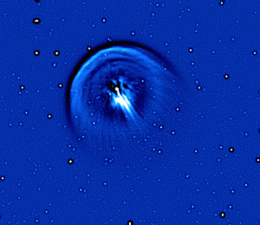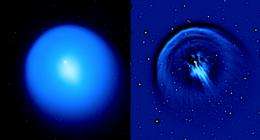Mini-Comets within a comet lit up 17P/Holmes during megaoutburst

Astronomers from the University of California, Los Angeles and the University of Hawaii have discovered multiple fragments ejected during the largest cometary outburst ever witnessed. Images and animations showing fragments rapidly flying away from the nucleus of comet 17P/Holmes will be presented by Rachel Stevenson at the European Planetary Science Congress in Potsdam, Germany, on Wednesday 16 September.
Stevenson, together with colleagues Jan Kleyna and David Jewitt, began observing comet Holmes in October 2007 soon after it was reported that the small (3.6 km wide) body had brightened by a million times in less than a day. They continued observing for several weeks after the outburst using the Canada- France- Hawaii Telescope in Hawaii and watched as the dust cloud ejected by the comet grew to be larger than the Sun.
The astronomers examined a sequence of images taken over nine nights in November 2007 using a digital filter that enhances sharp discontinuities within images. The filter, called a Laplacian filter, is particularly good at picking out faint small-scale features that would otherwise remain undetected against the bright background of the expanding comet. They found numerous small objects that moved radially away from the nucleus at speeds up to 125 metres per second (280 mph). These objects were too bright to simply be bare rocks, but instead were more like mini-comets creating their own dust clouds as the ice sublimated from their surfaces.

“Initially we thought this comet was unique simply because of the scale of the outburst," said Stevenson. “But we soon realized that the aftermath of the outburst showed unusual features, such as these fast-moving fragments, that have not been detected around other comets."
While cometary outbursts are common, their causes are unknown. One possibility is that internal pressure built up as the comet moved closer to the Sun and sub-surface ices evaporated.
The pressure eventually became too great and part of the surface broke away, releasing a huge cloud of dust and gas, as well as larger fragments.
Surprisingly, the solid nucleus of comet Holmes survived the outburst and continued on its orbit, seemingly unperturbed. Holmes takes approximately 6 years to circle the Sun, and travels between the inner edge of the asteroid belt to beyond Jupiter. The comet is now moving away from the Sun but will return to its closest approach to the Sun in 2014, when astronomers will examine it for signs of further outbursts.
Source: Europlanet




















